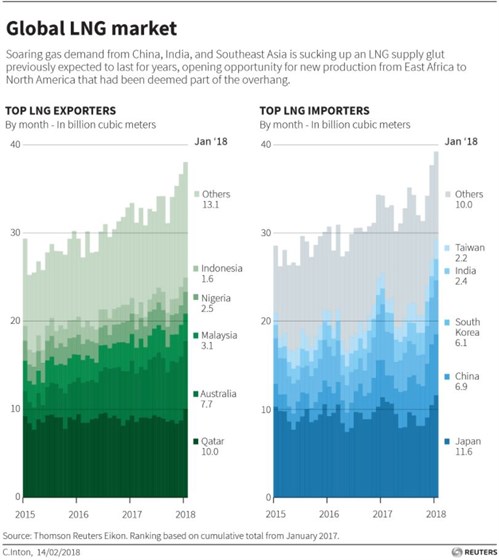Interest in LNG fires up again, but the market's different now
LAUNCESTON, Australia, Feb 22 (Reuters) - If you were looking for signs that the liquefied natural gas (LNG) merry-go-round is starting to spin a little faster, the announcement of a planned massive expansion in Papua New Guinea is ample evidence.
 |
| Top LNG exporters, importers |
Global majors Exxon Mobil and Total are considering plans to double LNG exports from Papua New Guinea to about 16 million tonnes per annum, their partner Oil Search said on Feb. 20.
If approved, three new trains would be added to the existing Exxon-operated PNG LNG facility, with natural gas from Total's fields supplying two of the units and the third using existing fields and a new Exxon development.
While a final investment decision on the $13 billion expansion is still more than a year away, it's a clear sign that LNG producers believe the market is headed for a deficit and that large-scale projects are once again viable.
The LNG industry's recent development has been characterised by periods of massive investment and capacity expansions followed by lulls amid fears of low prices caused by oversupply.
The past decade has witnessed a rapid expansion of LNG capacity, with eight large-scale projects being built in Australia and six in the United States, as well as some others such as the Yamal venture in Russia.
Most of these developments have started, or are due to start, within a fairly narrow time frame between 2016 and 2020, a bunching together of new capacity that led to widespread market concern of oversupply and weak prices.
While it's still likely that there may be some oversupply this year, and perhaps until the early 2020s, the market reality is that new LNG buyers in Asia and a surge in Chinese demand has eaten away most of the expected surplus.
China imported 38 million tonnes of LNG in 2017, up 46.4 percent from the prior year, according to customs data.
A few years ago there were forecasts that China would import as much as 60 million tonnes of LNG a year by the middle of the next decade, predictions that started to look wildly optimistic as LNG imports struggled to gain traction in the 2014-2016 period.
However, a concerted effort by the authorities in Beijing to switch from more-polluting coal to natural gas has seen a surge in LNG imports, one that is likely to continue as cleaning up air pollution remains a priority, making 60 million tonnes per annum a realistic target.
The attractiveness of LNG relative to coal has also been boosted by a declining spot price for LNG in Asia, which at the current $7.90 per million British thermal units (mmBtu) is less than half the peak of $20.50 reached in February 2014.
It's not just China turning to LNG, with other Asian countries including India, Pakistan, Vietnam, the Philippines, Sri Lanka and others all planning to increase their capacity to re-gasify the super-chilled fuel.
NEW PROJECTS FACE CHANGING ENVIRONMENT
This new dynamic hasn't gone unnoticed by LNG companies, which are starting to ramp up talk and action about new projects after a quiet few years spent trying to complete existing developments while navigating lower prices and buyer demands for more flexible contracts.
Australia's Woodside Petroleum, operator of the existing 16 million tonne per annum Northwest Shelf project, recently launched an almost $2 billion capital raising in order to buy control of an offshore field from partner Exxon, and use the natural gas for an expansion of its Pluto LNG plant.
Mozambique's vast resources are also getting closer to coming to market with Anadarko Petroleum announcing a sales agreement on Feb. 20, bringing it closer to a final investment decision.
However, all these potential projects are facing quite a different market to the last round of mega-developments that are now coming on stream.
Buyers, especially the majors in North Asia such as Japan, South Korea and China, have made it clear they want flexible contracts.
This means an end to destination clauses, an end, or at least substantial changes, to the method of pricing LNG against crude oil and considerably shorter-term contracts, or even more spot deliveries.
This makes it hard to secure the off-take agreements needed to secure funding for multi-billion dollar projects, meaning it's likely that those companies with strong balance sheets that they can leverage off will enjoy greater chances of success in developing a new LNG plant.
The LNG market is also likely to become more volatile and the seasonal swings may become more pronounced, especially if China remains the main driver of demand growth.
China's LNG demand is concentrated over the northern winter, when the fuel is used for mainly heating, replacing coal-fired boilers in both industry and residential use.
While power demand for air-conditioning does increase during summer, China has comparatively little gas-fired generation, meaning demand for coal and other forms of electricity, such as hydro and nuclear, shoulder the burden.
This dynamic is likely to lead to sharper price spikes during winter and declines in summer than has been the case in past years.
Overall, the LNG market is shifting from being staid and focused on the long term to one characterised by rising volatility, shorter-term deals and increasing innovation.
(Editing by Richard Pullin. The opinions expressed here are those of the author, a columnist for Reuters.)

- ExxonMobil halts 1-Bft3d blue hydrogen project in Texas
- Aramco and Yokogawa commission multiple autonomous control AI agents at Fadhili gas plant
- Ukraine will resume gas imports via Transbalkan route in November
- Mitsubishi to inject $260 MM into Brunei LNG project
- Freeport LNG (U.S.) on track to take in more natgas on Thursday after unit outage



Comments